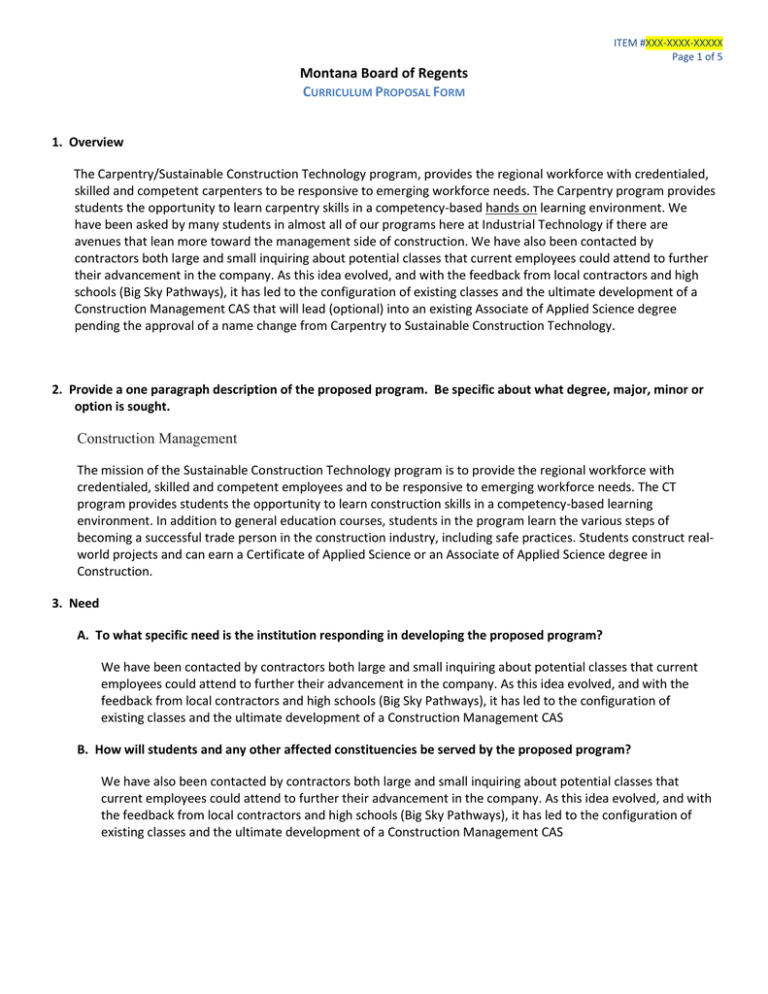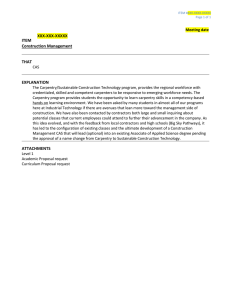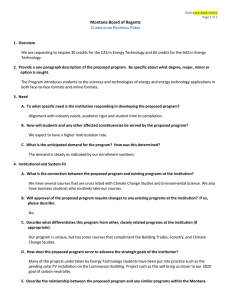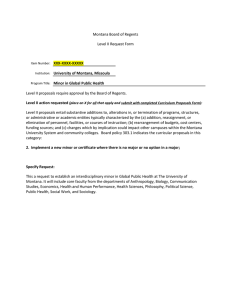Montana Board of Regents C P F
advertisement

ITEM #XXX-XXXX-XXXXX Page 1 of 5 Montana Board of Regents CURRICULUM PROPOSAL FORM 1. Overview The Carpentry/Sustainable Construction Technology program, provides the regional workforce with credentialed, skilled and competent carpenters to be responsive to emerging workforce needs. The Carpentry program provides students the opportunity to learn carpentry skills in a competency-based hands on learning environment. We have been asked by many students in almost all of our programs here at Industrial Technology if there are avenues that lean more toward the management side of construction. We have also been contacted by contractors both large and small inquiring about potential classes that current employees could attend to further their advancement in the company. As this idea evolved, and with the feedback from local contractors and high schools (Big Sky Pathways), it has led to the configuration of existing classes and the ultimate development of a Construction Management CAS that will lead (optional) into an existing Associate of Applied Science degree pending the approval of a name change from Carpentry to Sustainable Construction Technology. 2. Provide a one paragraph description of the proposed program. Be specific about what degree, major, minor or option is sought. Construction Management The mission of the Sustainable Construction Technology program is to provide the regional workforce with credentialed, skilled and competent employees and to be responsive to emerging workforce needs. The CT program provides students the opportunity to learn construction skills in a competency-based learning environment. In addition to general education courses, students in the program learn the various steps of becoming a successful trade person in the construction industry, including safe practices. Students construct realworld projects and can earn a Certificate of Applied Science or an Associate of Applied Science degree in Construction. 3. Need A. To what specific need is the institution responding in developing the proposed program? We have been contacted by contractors both large and small inquiring about potential classes that current employees could attend to further their advancement in the company. As this idea evolved, and with the feedback from local contractors and high schools (Big Sky Pathways), it has led to the configuration of existing classes and the ultimate development of a Construction Management CAS B. How will students and any other affected constituencies be served by the proposed program? We have also been contacted by contractors both large and small inquiring about potential classes that current employees could attend to further their advancement in the company. As this idea evolved, and with the feedback from local contractors and high schools (Big Sky Pathways), it has led to the configuration of existing classes and the ultimate development of a Construction Management CAS ITEM #XXX-XXXX-XXXXX Page 2 of 5 Montana Board of Regents CURRICULUM PROPOSAL FORM C. What is the anticipated demand for the program? How was this determined? Students have already enrolled in one of Industrial Technology’s’ current programs in anticipation of this cas approval among other changes that are being submitted through the proper channels. Student enrollment has increased (That is current students enrolled and actively attending class Spring 2016 semester) by 150% across Carpentry and Facility Management. This, one of multiple program requests, has allowed students to enroll at the beginning of any semester verses in the past where students could only enroll in the Fall. No waiting. In addition, one major construction contractor approached Industrial technology and will have a need this Spring for over 50 employees with basic construction knowledge just here in Missoula. That is not counting across the state and outlying areas across the country, 4. Institutional and System Fit A. What is the connection between the proposed program and existing programs at the institution? The Industrial technology department currently offers all of the necessary classes to complete this cas. This will simply be a configuration of existing course. B. Will approval of the proposed program require changes to any existing programs at the institution? If so, please describe. N/A C. Describe what differentiates this program from other, closely related programs at the institution (if appropriate). N/A D. How does the proposed program serve to advance the strategic goals of the institution? Increased enrollment and retention due to the flexibility of students to “zero in” on interests within the field verses a broad overview of construction. E. Describe the relationship between the proposed program and any similar programs within the Montana University System. In cases of substantial duplication, explain the need for the proposed program at an additional institution. Describe any efforts that were made to collaborate with these similar programs; and if no efforts were made, explain why. If articulation or transfer agreements have been developed for the substantially duplicated programs, please include the agreement(s) as part of the documentation. There have been small pockets of similar classes but nothing to the magnitude of changes and flexibility we are developing. As mentioned, this request is just one of many being proposed by The Industrial Technology Department. 5. Program Details A. Provide a detailed description of the proposed curriculum. Where possible, present the information in the form intended to appear in the catalog or other publications. NOTE: In the case of two-year degree programs and certificates of applied science, the curriculum should include enough detail to determine if the characteristics set out in Regents’ Policy 301.12 have been met. ITEM #XXX-XXXX-XXXXX Page 3 of 5 Montana Board of Regents CURRICULUM PROPOSAL FORM Certificate of Applied Science Construction Management The mission of the Sustainable Construction Technology program is to provide the regional workforce with credentialed, skilled and competent employees and to be responsive to emerging workforce needs. The CT program provides students the opportunity to learn construction skills in a competency-based learning environment. In addition to general education courses, students in the program learn the various steps of becoming a successful trade person in the construction industry, including safe practices. Students construct real-world projects and can earn a Certificate of Applied Science or an Associate of Applied Science degree in Construction. CSTN 120 - Carpentry Basics & Rough-In Framing – 5 Credits Introduction to the carpentry trade, including history, career opportunities, and requirements. The course covers building materials, fasteners, adhesives, hand tools, and power tools. OSHA rules and regulations for a safe working place and procedures for compliance are covered. This course includes a two-credit embedded lab. CSTN 142 - Interior & Exterior Finish Carpentry – 4 Credits Prereq: CSTN 120. Study of various types of siding, gutter systems, roof venting requirements, and framing with metal studs. Installation of sheathing, exterior siding, roofing felt, shingles, insulation vapor barriers, and stairs on small building constructed in CSTN 120. Installation of wood and metal doors. Demonstration of materials, layout and installation of suspended ceilings. Selection and installation of countertops, base cabinets and wall cabinets. Window, door, floor, ceiling trim and drywall are installed in a small building. This course includes a one-credit imbedded lab. CSTN 171 - Site Preparation, Foundation installation, Concrete placement – 3 Credits Introduces the process of distance measurement as well as differential and trigonometric leveling for site layout. It covers the principles, equipment, and methods used to perform the site layout tasks that require making angular measurements. This course is designed to also allow students to apply blueprint reading skills as a practical exercise. CSTN 261 - Building Management – 4 Credits Prereq: CSTN 120, 142, 171. Introduction to building business and project management including overhead costs, payroll costs, estimating and scheduling. Covers elements of payroll computation and preparation, payroll tax returns, information returns, and identification and compensation of ITEM #XXX-XXXX-XXXXX Page 4 of 5 Montana Board of Regents CURRICULUM PROPOSAL FORM independent contractors. Students are introduced to building cost estimating, and scheduling of subcontractors and building inspections. This course includes a one-credit imbedded lab. CSTN 279 - Commercial Construction – 4 Credits Prereq. CSTN 171, 120, 142. Study and develop skills in metal stud framing, commercial roofing systems, metal and masonry buildings, metal doors and door hardware, suspended ceilings, and fire rated commercial walls. General Education – 9 Credits Writ 111- 3cr Math 121 – 3cr Capp 120 – 3cr Comx 101 – 1cr B. Describe the planned implementation of the proposed program, including estimates of numbers of students at each stage. Minus the prerequisites mentioned above, students can enroll in classes whenever they are offered. Current students have been casually informed of our proposal and are very excited. Enrollment and expected growth will drive attendance. (Excuse me if that sounds obvious. It is not my intent) 6. Resources A. Will additional faculty resources be required to implement this program? If yes, please describe the need and indicate the plan for meeting this need. No B. Are other, additional resources required to ensure the success of the proposed program? If yes, please describe the need and indicate the plan for meeting this need. Not at this time. The overall program is expected to grow and we have a long term plan that will eventually, in the years that come, require additional resources. We are already working with contractors both large and small to assist in many ways with these resources. 7. Assessment How will the success of the program be measured? The measurement of success will be based on the program eventually becoming self-supportive as it grows and more companies get involved. 8. Process Leading to Submission Describe the process of developing and approving the proposed program. Indicate, where appropriate, involvement by faculty, students, community members, potential employers, accrediting agencies, etc. The above statements pretty much sum it up. We have a couple of local contractors and just as many companies that are willing to speak to their commitment if it becomes necessary. ITEM #XXX-XXXX-XXXXX Page 5 of 5 Montana Board of Regents CURRICULUM PROPOSAL FORM





